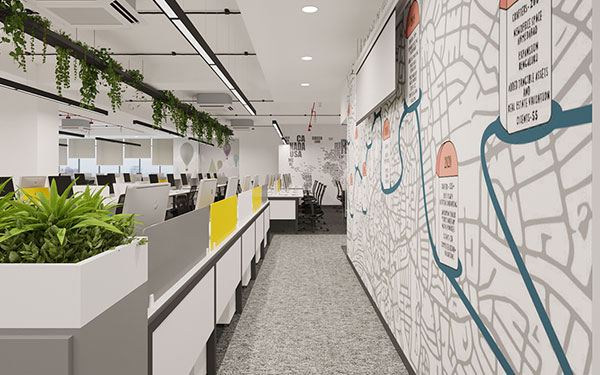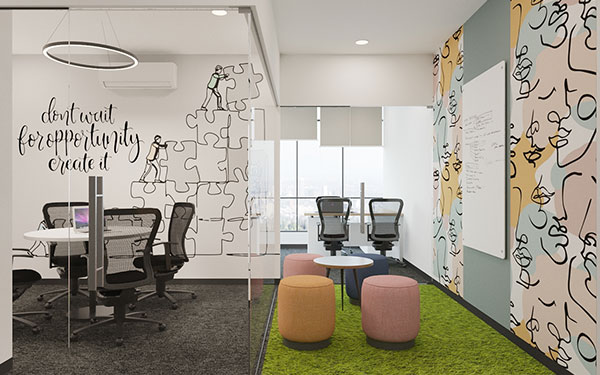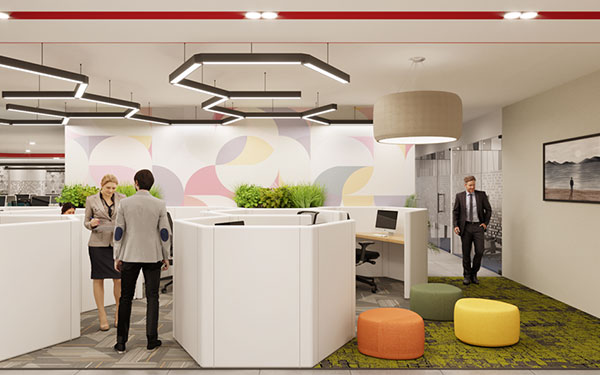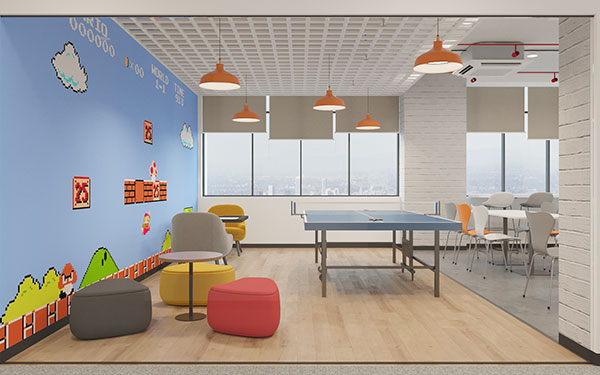What are some tips for designing a functional and stylish bank interior?
Designing a functional and stylish bank interior is crucial to creating a positive customer experience. Here are some tips for designing a bank interior that is both functional and stylish:
Consider the Customer Journey:
One of the most important factors in designing a functional bank interior is considering the customer journey. Interior company first understands how customers enter the bank, how they move through the space, and how they interact with bank staff. By understanding this journey, interior company designs a layout and builds a space that is intuitive and easy to navigate.
Focus on Security:
Security is a key consideration in bank interior design.Interior company use physical barriers such as bulletproof glass, metal detectors, or security cameras, that create a safe and secure environment for both customers and staff.
Create a Sense of Warmth and Comfort:
Despite the focus on security, it's important to create a sense of warmth and comfort in a bank interior. This can be achieved through the use of warm colors, comfortable seating, and soft lighting. By creating a welcoming environment, customers are more likely to feel relaxed and at ease, which can improve their overall banking experience.
Use Technology to Enhance the Customer Experience:
Technology plays an important role in modern bank interior design. Interactive kiosks, touch screens, and digital signage can all be used to enhance the customer experience and streamline banking processes. By leveraging technology, banks can create a more efficient and engaging banking experience for their customers.
Prioritize Functionality:
Functionality is key in bank interior design. Efficient queuing systems, ergonomic seating, and clearly marked signage are all essential components of a functional bank interior. By designing a space that prioritizes functionality, you can improve the overall customer experience and increase efficiency.
Choose High-Quality Materials:
The materials used in a bank interior can have a big impact on the overall aesthetic of the space. High-quality materials such as marble, granite, and polished metal can create a sleek and sophisticated look, while warm woods and soft fabrics can add a sense of warmth and comfort. By choosing high-quality materials, you can create a stylish and sophisticated bank interior that is both functional and inviting.
Consider Privacy:
Privacy is an important consideration in bank interior design. Private meeting rooms, soundproof glass, and partitioned desks can all be used to create a sense of privacy and confidentiality for customers. By considering privacy in the design of a bank interior, you can create a space that is both secure and comfortable for customers.
In conclusion, designing a functional and stylish bank interior requires careful consideration of the customer journey, security, comfort, technology, functionality, materials, and privacy. By prioritizing these factors, interior company create a bank interior that is both efficient and inviting, enhancing the overall customer experience and building trust and loyalty with their customers.
What are some ways to incorporate interactive elements into commercial interior Design?
Commercial interior company incorporates interactive elements into commercial interior design which is an effective way to engage customers, promote brand awareness, and increase customer satisfaction. Here are some ways to incorporate interactive elements into commercial interior design.
Interactive Displays:
Interactive displays are a popular way to engage customers in commercial spaces. They can be used to showcase products, provide information, or even offer interactive experiences. For example, a clothing store could use an interactive display to allow customers to see how clothes would look on them, while a car dealership could use a display to allow customers to customize their car options.


Interactive Art:
Art can be used to create a unique and engaging atmosphere in a commercial space. Interactive art, such as sculptures or installations, can be used to create an immersive experience for customers. For example, a retail store could use an interactive art installation to create a unique and memorable shopping experience.
Interactive Lighting:
Interactive lighting is a creative way to engage customers in a commercial space. This can include LED lighting that changes color or responds to movement, or lighting that is controlled by a customer's smartphone. For example, a restaurant could use interactive lighting to create a unique and inviting atmosphere for customers.


Gamification:
Gamification is the use of game elements, such as points, badges, or leaderboards, in non-game contexts. This can be a powerful tool to engage customers in a commercial space. For example, a fitness studio could use gamification to encourage customers to attend more classes or achieve their fitness goals.
Interactive Seating:
Interactive seating is a creative way to engage customers in a commercial space. This can include seating that changes color or shape, or seating that incorporates technology such as sound or lighting. For example, a movie theater could use interactive seating to create a unique and immersive movie-watching experience.
Incorporating interactive elements into commercial interior design can be a powerful tool to engage customers, promote brand awareness, and increase customer satisfaction. By using technologies such as virtual reality, augmented reality, and interactive displays, commercial spaces can create unique and memorable experiences for customers, leading to increased engagement and loyalty.

Transform Your Workspace Today!
From innovative design to flawless execution, we turn your vision into a dynamic, functional, and inspiring office space. Whether you're renovating or starting fresh, our tailored solutions will elevate your workspace to the next level.
+91 9211584298
FAQ About Color Combination for Office
- Detailed consultation to understand your vision.
- 3D visualization of the design.
- Sourcing high-quality materials.
- Expert project execution with a focus on timelines and budgets.
- As a leading commercial interior designer, Flipspaces ensures a seamless experience from concept to completion.

 Design and Build
Design and Build Product Supply
Product Supply Blogs
Blogs Newsroom
Newsroom